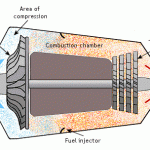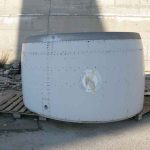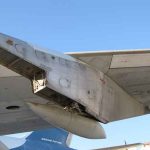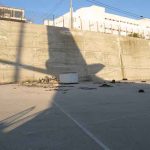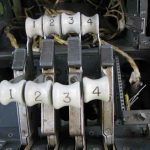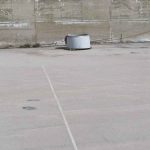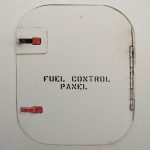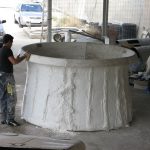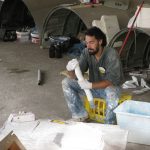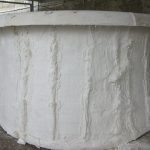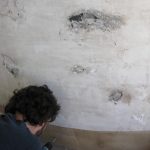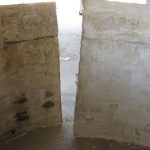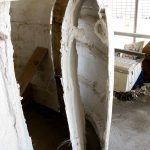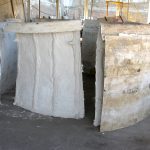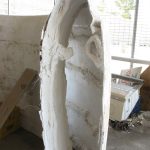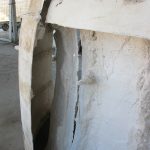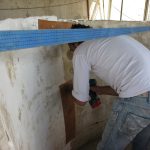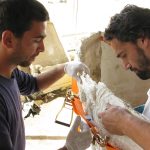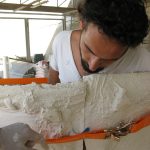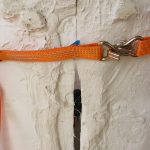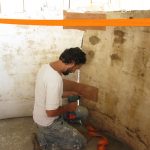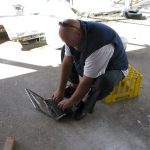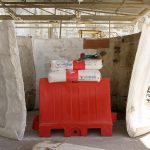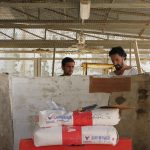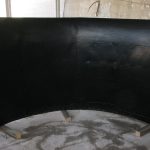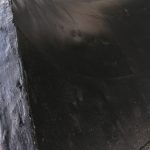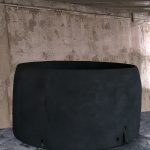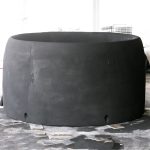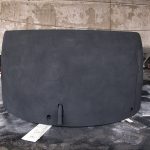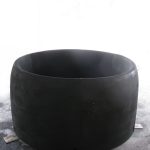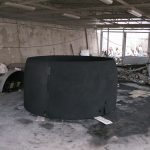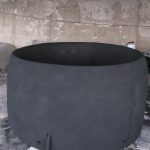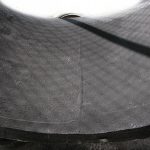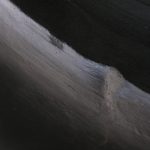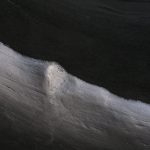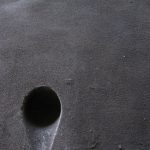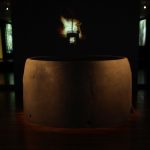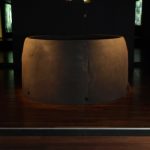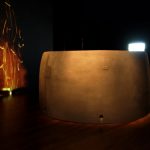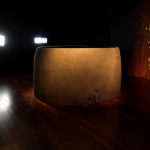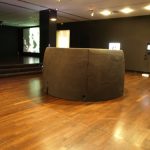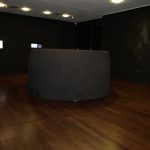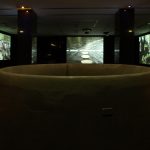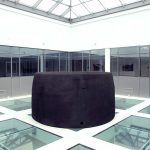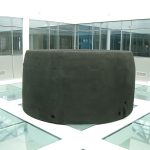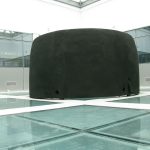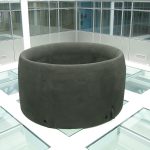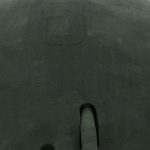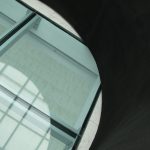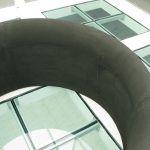Intake, Boeing 747-200.
In view of the news about millions of tons of ash from the Eyjafjallajökull volcano eruptions in Iceland that grounded planes across Europe in April and May 2010, the artist adapted the next phase of the project to existing conditions. Ash, the remains of the bonfire were shipped in containers after leaving Skowhegan to the deserted airport of Hellenikon in Athens, an area which is scheduled to become a major metropolitan park in Greece. The project entitled “Intake” created by the visual artist Theodoros Zafeiropoulos in 2010. Adapting the method of cold-cast carbon into elastomeric mold, the sculpture captures with absolute detail and fidelity Boeing 747 engine’s nozzle air mass inflow. The Jumbo Jet, the world’s most famous double-deck commercial aircraft, a symbolic airplane for the Hellenic Aviation, retired from the active duty fleet of the Olympic Airways in 1999 and today displays as historic exhibit at the Museum of Commercial Aviation located in the former Athens Airport, “Hellinikon”. As constructive material the artist used the cremated ashes of a single Poplar tree from the area Skowhegan Maine in the United States. The manufacturing process preceded by staged practices of material transformation. The project operates as a poetic metaphor and anthropological monument over the lack of current geological stability, physical deterioration, sociability and eco-protection. The ashes, the remnants of the purgatorial bonfire is the potential evidence linking to the millions of tones of ash from the volcanic eruptions in Iceland “Eyjafjallajökull”, a fact that literally grounded the air-transportation across Europe in April and May 2010. The particular aircraft engine is the main part of an internal combustion chamber, an essential and powerful air pump. The fundamental function of an air pump creates in this way the conceptual link between the dust from the eruption and the remains of the bonfire of Skowhegan. The technological development of such highly complex jet engines with an increasing efficiency and validity can be linked with the growing human need for exploration, the risks posed to a modern Daedalus and the growing failure of technology. The sculpture was first presented in the exhibition ‘Intake’ in the American Union in January 2011.
Curated and catalogue texts by: Sotirios Bahtsetzis.
Technical Support: Vasilis Gerodimos
Photographs: Giorgio Boulasidis
Στον απόηχο των ειδήσεων για τους εκατομμύρια τόνους στάχτης από τις εκρήξεις του ηφαιστείου Eyjafjallajökull στην Ισλανδία που καθήλωσαν τα αεροπλάνα σχεδόν σε όλη την Ευρώπη τον Απρίλιο και τον Μάιο του 2010, ο καλλιτέχνης προσάρμοσε την επόμενη φάση του έργου του στις δεδομένες συνθήκες. Η στάχτη, τα απομεινάρια της φωτιάς, αφότου απομακρύνθηκαν από το Skowhegan μεταφέρθηκαν σε δοχεία στο εγκαταλελειμμένο αεροδρόμιο του Ελληνικού στην Αθήνα, σε μία περιοχή που προορίζεται να μετατραπεί στο μεγαλύτερο μητροπολιτικό πάρκο της Ελλάδας. Το έργο με τίτλο Intake κατασκευάστηκε απο τον εικαστικό καλλιτέχνη Θεόδωρο Ζαφειρόπουλο το 2010 με την μέθοδο ψυχρής χύτευσης άνθρακα στο εσωτερικό ελαστομερούς καλουπιού και αποτυπώνει με απόλυτη πιστότητα το στόμιο εισροής αέριας μάζας στο εσωτερικό του κινητήρα απο ενα αεροσκάφος ορόσημο για την Ελληνική Αεροπλοοία. Το Jumbo Jet, το πιο γνωστό παγκοσμίως διόρωφο επιβατικό αεροσκάφος. Αποσύρθηκε απο την ενεργή δράση των Ολυμπιακών Αερογραμμών το 1999 και μέχρι σήμερα ανήκει ως έκθεμα στο Μουσείο Πολιτικής Αεροπορίας στο Αεροδρόμιο Ελληνικού. Ένας τέτοιος κινητήρας αεροσκάφους που αποτελεί το βασικό τμήμα μίας σύγχρονης μηχανής εσωτερικής καύσης, είναι στην ουσία μία πανίσχυρη αντλία αέρος. Η τεχνική της αντλίας αέρος δημιουργεί κατ’ αυτόν τον τρόπο τον εννοιολογικό σύνδεσμο μεταξύ της σκόνης από την έκρηξη του ηφαιστείου και τα απομεινάρια της πυράς του Skowhegan. Με την εξέλιξη τέτοιων εξαιρετικά σύνθετων κινητήρων jet, η αυξανόμενη αποδοτικότητα και ισχύς τους μπορεί να συνδεθεί με την αυξανόμενη ανάγκη του ανθρωπου για εξερεύνηση, τους κινδύνους στους οποίους εκτίθεται ένας σύγχρονος Δαίδαλος αλλά και με την ολοένα αυξανόμενη, ενδεχόμενη αποτυχία της τεχνολογίας. Ο κινητήρας του αεροσκάφους εξελίσσεται στην απόλυτη εικόνα αυτών των διαδοχικών «αποτυχιών» με βάση τις οποίες έχει αναπτυχθεί η συνολικη πρακτικη του έργου. Το γλυπτό εκτέθηκε για πρώτη φορά στα πλαίσια της έκθεσης ‘Intake’στην Ελληνοαμερικανική Ένωση τον Ιανουάριο του 2011.
Επιμέλεια έκθεσης και κειμένων καταλόγου: Σωτήριος Μπαχτσετζής.
Τεχνική Υποστήριξη: Βασίλης Γεροδήμος.
Φωτογραφήσεις: Γιώργος Μπουλασίδης.



